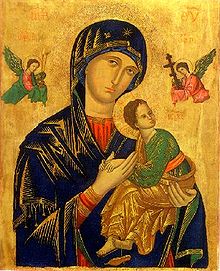
Mary has been one of the major subjects of Western art for centuries. There is an enormous quantity of Marian art in the Catholic Church, covering both devotional subjects such as the Virgin and Child and a range of narrative subjects from the Life of the Virgin, often arranged in cycles. Most medieval painters, and from the Reformation to about 1800 most from Catholic countries, have produced works, including old masters such as Michelangelo and Botticelli.[1]
Marian art forms part of the fabric of Catholic Marian culture through their emotional impact on her veneration. Images such as Our Lady of Guadalupe and the many artistic renditions of it as statues are not simply works of art but are a central element of the daily lives of the Mexican people.[2] Both Hidalgo and Zapata flew Guadalupan flags and depictions of the Virgin of Guadalupe continue to remain a key unifying element in the Mexican nation.[3] The study of Mary via the field of Mariology is thus inherently intertwined with Marian art.[4]
The body of teachings that constitute Catholic Mariology consist of four basic Marian dogmas: Perpetual virginity, Mother of God, Immaculate Conception and Assumption into Heaven, derived from Biblical scripture, the writings of the Church Fathers, and the traditions of the Church. Other influences on Marian art have been the Feast days of the Church, Marian apparitions, writings of the saints and popular devotions such as the rosary, the Stations of the Cross, or total consecration, and also papal initiatives, and Marian papal encyclicals and Apostolic Letters.
| Part of a series on the |
| Mariology of the Catholic Church |
|---|
 |
|
|
- ^ Timothy Verdon, 2006, Mary in Western Art ISBN 978-0-9712981-9-4
- ^ Cite error: The named reference
Meadewas invoked but never defined (see the help page). - ^ The Virgin of Guadalupe by Maxwell E. Johnson 2003 ISBN 0-7425-2284-9 pp. 41–43
- ^ Caroline Ebertshauser et al. 1998 Mary: Art, Culture, and Religion through the Ages ISBN 978-0-8245-1760-1